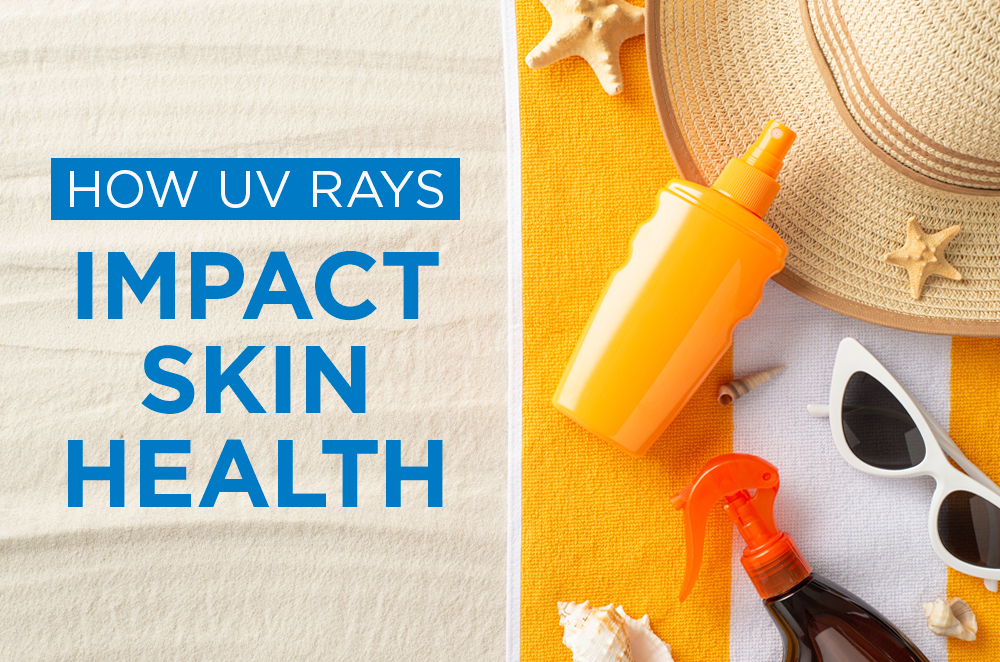We often talk about the critical link between UV rays and skin cancer. And for good reason – skin cancer is the most common cancer in the United States, and prevention is paramount. However, focusing solely on cancer sometimes overshadows the other significant, often visible, ways that UV rays impact the health and appearance of our skin.
In this blog post, let’s explore how unchecked sun exposure can prematurely age you, create unwelcome dark spots, and generally compromise your skin’s vitality, even if cancer never develops.
Premature Aging
Have you ever wondered why some people look older than their years, even if they’ve never had a serious sunburn? Often, it’s the cumulative effect of UV radiation. This is what we call photoaging, and it’s essentially the sun hitting the fast-forward button on your skin’s aging process.
Here’s how it manifests:
Wrinkles and Fine Lines: UV radiation damages collagen and elastin fibers, the proteins that give your skin its firmness and elasticity. Consequently, over time, this breakdown leads to sagging skin, pronounced wrinkles, and fine lines, particularly around the eyes (crow’s feet), mouth, and forehead.
Leathery Texture: Furthermore, chronic sun exposure can cause the skin to thicken and develop a coarse, leathery texture, losing its natural smoothness.
Reduced Elasticity: As a result, as collagen and elastin degrade, your skin loses its ability to “snap back,” contributing to a tired, less youthful appearance.
Uneven Skin Tone and Pigmentation Changes
You know those pesky brown spots that seem to pop up out of nowhere, especially on your face, hands, and chest? Yep, those are often sun-induced! They’re commonly called sunspots, age spots, or liver spots (though they have nothing to do with your liver!).
Sunspots (Age and Liver Spots): These are flat, benign (non-cancerous) areas of increased pigmentation that appear on skin frequently exposed to the sun. They’re more common as we age, but they’re a direct result of cumulative UV damage, not simply age itself.
Melasma: Often called the “mask of pregnancy,” melasma causes patchy brown or gray-brown spots, primarily on the face. While hormonal changes (like pregnancy or birth control) can trigger it, UV exposure is a major aggravating factor and can make it significantly worse or more persistent.
Uneven Skin Tone: Even without distinct spots, consistent sun exposure can lead to a generally uneven skin tone, with areas of hyperpigmentation (darker) and hypopigmentation (lighter) creating a mottled appearance.
Telangiectasias (Spider Veins)
Beyond pigmentation changes, those tiny, visible blood vessels that often appear on the nose, cheeks, and chest are frequently a result of sun damage. UV rays weaken the walls of small blood vessels, causing them to dilate and become more prominent.
Dryness and Roughness
While it’s not always immediately obvious, long-term exposure to UV rays can compromise the skin’s natural barrier function, leading to increased dryness, roughness, and a dull complexion. Therefore, the skin becomes less efficient at retaining moisture, making it more vulnerable to environmental stressors.
Why It Matters (Beyond Aesthetics)
While premature aging and dark spots might seem like purely cosmetic concerns, they’re actually indicators of deeper skin damage. This damage, over time, can increase your risk for certain skin conditions and even make your skin more susceptible to other environmental stressors. Plus, a healthy skin barrier is crucial for overall skin health and protecting against infections. Exposure to UV rays can weaken this barrier, leading to dryness and increased sensitivity.
What Can You Do About It?
The good news is, it’s never too late to start protecting your skin!
- Sunscreen, Every Single Day: This is non-negotiable. Use a broad-spectrum sunscreen with an SPF of 30 or higher, even on cloudy days and in winter. Reapply every two hours, or more often if you’re swimming or sweating.
- Seek Shade: Especially during peak UV hours (10 AM to 4 PM), try to stay in the shade.
- Wear Protective Clothing: Long-sleeved shirts, pants, wide-brimmed hats, and UV-blocking sunglasses offer excellent protection.
- Regular Skin Checks: Get to know your skin! If you notice any new or changing spots, don’t hesitate to reach out to a healthcare professional.
Your skin is your body’s largest organ, and it works tirelessly to protect you. By understanding the impact of UV rays and taking proactive steps, you can help ensure that your skin remains healthy, vibrant, and resilient for years to come. If you have any concerns about your skin health, please consult with your primary care provider or a dermatologist.
Resources:
https://www.skincancer.org/risk-factors/uv-radiation/
https://pmc.ncbi.nlm.nih.gov/articles/PMC3709783/
https://my.clevelandclinic.org/health/diseases/10985-ultraviolet-radiation
Disclaimer:
The Comanche County Memorial Hospital website does not provide specific medical advice for individual cases. Comanche County Memorial Hospital does not endorse any medical or professional services obtained through information provided on this site, articles on the site, or any links on this site.
Use of the information obtained by the Comanche County Memorial Hospital website does not replace medical advice given by a qualified medical provider to meet the medical needs of our readers or others.
While content is frequently updated, medical information changes quickly. Information may be out of date, and/or contain inaccuracies or typographical errors. For questions or concerns, please contact us at contact@ccmhhealth.com.

